by Dirk H.R. Spennemann
The Marshall Islands, comprising 29 atolls and 5 islands, are located in the north-west equatorial Pacific. The atolls of the Marshall Islands, comprising well over 1200 islands and islets are scattered about in an ocean area of well over 600,000 square miles. The atolls support narrow sand cays set on the more or less ring-like reef platform. Only few of the islands on the atolls have a land area greater than one square kilometre and on most of them the distance between the lagoon and the ocean side is less than 300 metres.
Today traditional Marshallese tattooing is no longer practised and the meaning of most of the ornaments and ornament fields is no longer known. In fact, only very few Marshallese of the 1990′s can remember having seen people with full traditional tattoos. Thus we have to turn to historic sources. Aspects of tattooing in the Marshall Islands are described by a variety of ethnographic sources mainly of the late 19th and early 20th century, but a comprehensive treatment of the topic was not compiled until 1992.
An in-depth reading of these sources made it clear how little information had in fact been recorded at a time when a large number of people still wore tattoos and knew their meanings, as well as the traditions related to the motifs and the chants sung at the ceremonies. Then, there were still people who knew how to tattoo, although with the progressive impact of the Christian faith the ceremony itself had become more or less extinct. Language problems, and possibly also psychological aversion on behalf of the Marshallese, probably due to Christianity-induced guilt complexes, may have been inhibitive factors in the transmission of knowledge.
HISTORY OF TATTOOING IN THE MARSHALLS
Based on archaeological evidence, the first people to settle on the atolls which now make up the Republic of the Marshall Islands arrived between 1000 and 500 B.C. Over the centuries they maximised the horticultural potential offered by the scarce land on the atolls and developed a complex social system with little emphasis on permanent structures. Transmission of information was oral, by word of mouth; a reliable method to hand down one’s skills, information and social regulations, but subject to as much intentional modification and alteration of content as is provided by modern news coverage.
Over two millennia after settlement the first European visitors arrived on the scene and the first written accounts appear. Most likely the first Europeans to touch upon the atolls of the Marshall Islands were members of a Spanish expedition under the command of Alvaro de Saavedra, who arrived in October 1529 on a return voyage from the Philippines to Mexico. Saavedra encountered a northwestern atoll of the Marshall Islands, possibly Ujelang. A brief encounter with the heavily tattooed natives seems to have impressed the Spaniards so much that they named the entire island group “Los Pintados”-the painted. No details of the appearance of the tattoos are known.
The next visitors to stumble upon the atolls were Captains Gilbert and Marshall, en route from Port Jackson (Sydney, Australia) to the United Kingdom via China. Their observations, like those of several subsequent visitors, Spanish, British and American, do not touch on tattooing. The earliest more detailed descriptions we have of Marshallese tattooing stem from members of the Russian Exploring Expedition under the command of Captain Otto von Kotzebue, who visited the northeastern Marshall Islands first in 1816 and 1817, and then again in 1824. The German Adalbert von Chamisso, naturalist on the expedition, even desperately ventured to obtain a tattoo-to no avail. In his eyes, “tattooing neither covers nor disfigures the body, but rather blends in with it in graceful adornment and seems to enhance its beauty”.
The expedition’s artist, Choris, provided a number of studies of tattooed men and women. After the Russians left, little ethnographic work was done in the Marshall Islands for over half a century.
The later part of the 19th century saw the Marshall Islands becoming drawn into the German sphere of commercial interests and ultimately in 1885 a German protectorate. Subsequently a great number of German scholars, priests and administrators dealt with Marshallese ethnography in general and Marshallese tattooing in particular either in passing or in greater detail. The traders Hernsheim and Hager provided short summaries of Marshallese life and custom for an interested audience in Germany, but mainly dwelt onthe potential economic importance of the atolls of the Marshall Islands for fledgling German colonial aspirations.
The descriptions of the scholars Finsch and Kubary are more detailed than those of the traders although the descriptions especially of Finsch, contain some misconceptions, possibly caused by the inability to speak Marshallese. Some other information dating to the late 19th century is provided by accounts of shipwrecked people, such as Eisenhardt or Humphrey.
German colonial administrators and doctors filed a number of formal reports, most of which were published in the official journals. The administrators, their spouses as well as naval officers and civilian visitors also published a number of informal articles in colonial newspapers and magazines, which contain additional information although mainly of a more general nature. Soon after its establishment in 1904, the Catholic mission in Jaluit began to compete with the Protestant missionaries who had been well entrenched for almost half a century. The Catholic fathers collected traditions and ethnographic information, as well as worked on the Marshallese language. Father Erdland published a comprehensive ethnography and a dictionary, both of which discuss tattooing at length. Erdland’s dictionary lists a number of terms for tattooing on body parts, some of which seem to refer to motifs commonly used on that body part or ornament zone.
Following his two months sojourn in the Marshall Islands in 1897/1898 Augustin Kramer wrote a paper on mat weaving and tattooing in 1904, and included tattooing in a monograph on his trip published two years later. In 1910 Kramer again visited the Marshall Islands, this time with the German South Sea Expedition, and published the entire ethnographic material together with Hans Nevermann in 1938 as a volume of a series covering the 1910 expedition. Tattooing is again reviewed, and all other German sources are commented upon.
THE DEMISE OF TATTOOING
Yet at that time, tattooing was on the rapid decline. Tattooing had largely ceased in the second half of the 19th century, so that Otto Finsch, discussing tattooing needles, was forced to state that “in 1879 it was no longer easy to obtain such implements.” Along with the teachings of the Bible, the missionaries brought along their set of moral, ethical and aesthetic values, which were-of course-those of the contemporary society of their home country, and more to the point, the values of their own class level. It was these values then, which they superimposed by persuasion or force on the peoples of the Pacific, who until then had been able to survive quite well without the doubtful blessings of Christiandom and European society. Throughout the Pacific, tattooing, traditional attire, as well as traditional dancing were considered to be the apex of heathenism and therefore banned by missionaries of any denomination, be they Marists, London Missionary Society, Wesleyan, or American Protestant Revivalists.
In the Marshall Islands the Protestant missionaries of the American Board of Commissioners for Foreign Missions (“Boston Mission” were noted for interfering with domestic Marshallese issues. This disruption of Marshallese customs encompassed almost all aspects of daily social interaction. Tattooing was a custom which the missionaries had to put an end to for a number of reasons, each equally compelling to the self-righteous souls from rural backgrounds:
*Tattooing was connected with the old traditional way of life and the very expression of both status and group identity they were set to modify.
*Tattooing was closely interwoven with traditional religious and spiritual beliefs, and thus “heathen”.
*Tattooing was perceived to be aesthetically offensive to theEuropean eye.
*In the 19th century both British and U.S. penal systems identified released convicts and Army deserters by their tattoos.
*A Bible reference existed mentioning that the Israelites shall not be tattooed (Leviticus XIX:28) – hence tattooing was supposed to be un-Christian.
On the balance, therefore, the missionary abhorrence towards tattooing was partially based on European narrow-mindedness and European ideals of beauty and aesthetics, and-for a fundamentalist-was morally justifiable by the Bible.
Often, however, the missionary impact is downplayed and the general Europeanisation is blamed for the demise of the social systems. The fact that it was the Christian missionaries and not the general Europeanisation of the Marshall Islands which brought about the departure from clothing and body ornamentation customs becomes clear if one considers that in the mid-1880s tattooing was still practiced in the northern atolls, where Christian religion had not yet gained a foothold:
“The Christian influence of the mission has changed the original hairdo of the natives, and long hair is forbidden as unchristian … Where the missionaries have not penetrated, on all northern islands and [the] Ratak [Chain], the old customs still prevail, as does the characteristic hairdo …” and “The original native customs are still to be firmly entrenched in the northern islands of the group. Here tattooing and flower decorations are still en vogue, as well as the enormous distention of the ear lobes.”
The speed with which the missionaries could effect this change is astonishing. Tattooing was banned soon after the missionaries arrival on Ebon. Since the special rites associated with tattooing in the Marshall Islands had also a religious significance, the Ebonese shortly after the arrival of the European missionaries showed reluctance to carry out these rites in the missionaries presence; about 800 people left for Jaluit to do it in safety there.
It seems that the German colonial authorities had nothing or only little to say about tattooing. A survey of the Colonial Records showed that this matter played no role in the correspondence between the Station Chief in Jaluit and the Governour General in Rabaul, New Britain.
Following the outbreak of World War I, Japan seized the Marshall Islands from Germany in October 1914. Her possession of Micronesia was formalized in 1922 by the League of Nations. Unlike the Germans, the Japanese authorities, who took over the administration of the Marshall Islands following the outbreak of World War I, banned tattooing. According to a U.S. government publication of 1943:
“In 1922 the Japanese made tattooing or marking if one’s own or another’s body a police offense under penalty of enforced labor for a period not to exceed 30 days. This law may have been an effort to erase the physical marks of distinction separating chiefs from commoners. Or it may have been designed to eliminate a source of infection, since it is reported that, after being tattooed, a person usually develops a high fever.”
A number of Japanese ethnographers worked in the Marshall Islands, some of whom dealt with the topic of tattooing. The main Japanese work on Micronesian tattooing was done by Hasebe Kotond, who published a paper on Marshallese tattooing in 1930, wherein he discussed contemporary tattooing motifs and the decline of traditional Marshallese tattooing.
A census of 238 men conducted in 1930 showed only 56 to be tattooed with indigenous motifs. Of these the overwhelming majority (48) had only horizontal bands around their arms, as well as their legs. Most of these tattoos would have been completed during German colonial times, indicating how far the demise had gone.
In 1945 following Japan’s defeat in World War II the Marshall Islands became a Trust Territory of the United Nations, under administration by the United States of America. Ethnographic work conducted immediately after World War II shows that traditional tattooing was no longer practiced.
TRADITIONAL MARSHALLESE TATTOOS
Spiritually and conceptually Marshallese tattoos and their motifs are firmly rooted in the marine environment and Marshallese tattooing has drawn its elements and ideas for motifs from the sea. Many motifs, for example, are abstract forms of specific fish, or are to represent canoe parts or the canoe’s movements.
Even more to the point, tattooing in general is called eo, which according to the German ethnographer Krämer means the drawing of lines in general, because the lines of the blue-striped or regal angelfish (Pygoplites diacanthus) (see figure above), also called eo, were considered to be exemplary. The Regal Angelfish (Pygoplites diacanthus) was for the Marshallese the apex of clear lines and example for tattoos.
The Marshallese tattoo motifs are in general character very abstract pictographs. Their meaning, as outlined above, finds its roots in theenvironment: markings of fish, tooth marks of fish bites, motifs resembling shells or their ornaments and so on.
Marshallese tattoo motifs (right)and their natural examples (left)
1-Conus ebraeus and the addilajju motif;
2-Lepas anserifera and the elonwa motif;
3-Back of a turtle’s carapace and the bod motif;
4-Back of crab’s carapace and the addijokur motif;
5- Shark’s teeth and the pako motif.
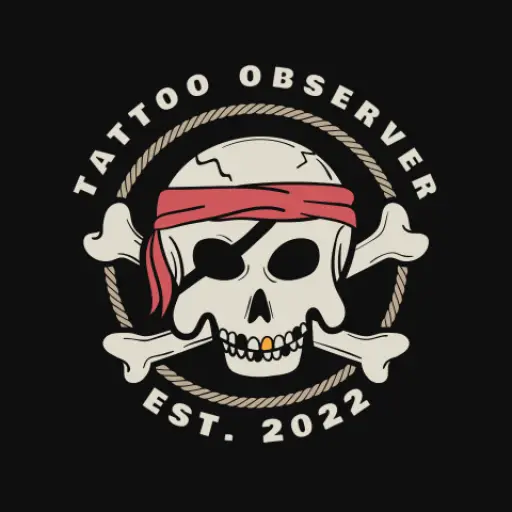






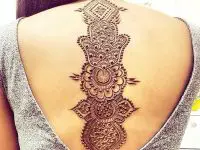



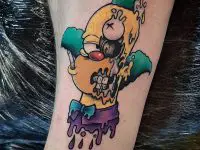




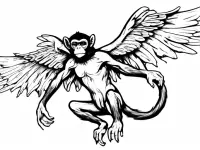
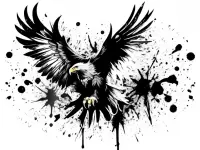
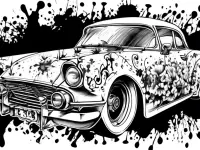



0 Comments